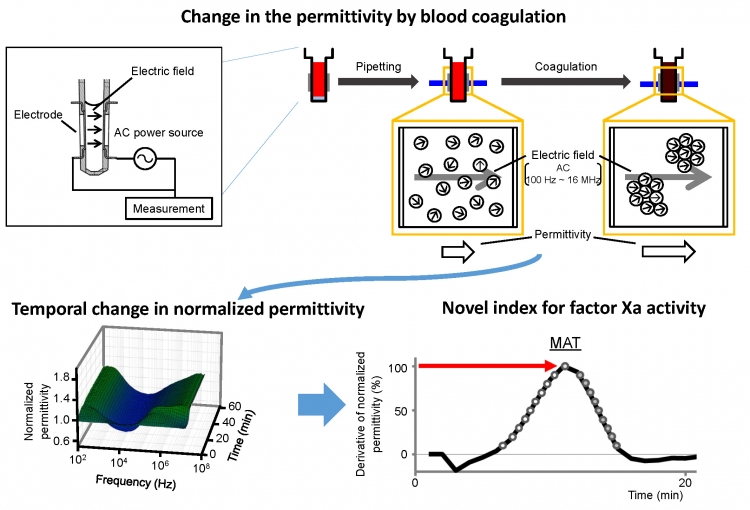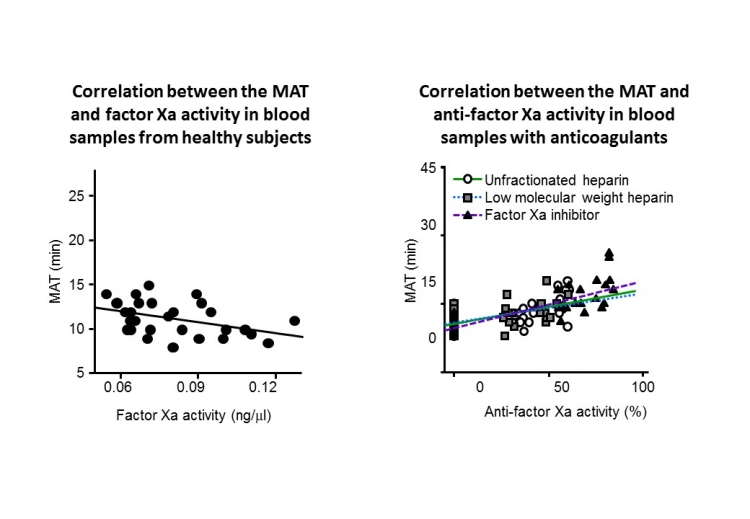"Stop that clot! Quantitative assessment of the blood coagulation cascade"
Tokyo, Japan – Thrombosis is a harmful activation of the clotting process that prevents bleeding in healthy people; thrombosis is associated with the occurrence of strokes, ischemic heart disease, and other blood vessel-related diseases. Pathological enhancement of the clotting cascade causes thrombosis, and activated factor X (FXa) plays a pivotal role in this process. Many methods have been attempted to quantitatively determine the activity of FXa during medical treatment for thrombosis; few have been both successful and easy to use, until now.
In a new study published in Scientific Reports, a research team from Tokyo Medical and Dental University (TMDU) investigated the use of dielectric blood coagulometry (DBCM), which primarily measures aggregation of red blood cells through time-dependent changes in the permittivity of blood (its ability to store an electrical charge in proportion to the external electric field), in order to detect changes in FXa activity in the presence of various drugs that inhibit the actions of FXa.
Thrombosis occurs as a result of the generation of thrombi (blood clots) from platelets and red blood cells. These blood clots can block blood vessels, causing tissue damage and broader disease in affected patients. Most available treatments cause a variety of side effects due to their broad treatment mechanisms. Recent drug development has specifically targeted single parts of the coagulation process, such as FXa. Currently, specific inhibitors of FXa are widely regarded as safe and effective for clinical treatment. However, the methods to assess the effects of these drugs are not easy to use, which has limited the clinical usefulness of these drugs for some patients, such as elderly patients or those with renal dysfunction.
“DBCM has been used to measure whole blood coagulability, even when changes were very small in magnitude,” says Tetsuo Sasano, corresponding author on the study. “We suspected that we could use DBCM to evaluate FXa activity separately from whole blood coagulability.”

Figure 1. The principle of the measurement of blood coagulability and the index for factor Xa activity
(top) Citrated whole blood is put between electrodes. When the blood starts coagulation, the permittivity measured by alternating current (AC) increases in relation to the aggregation and deformation of blood cells.
(bottom) Temporal change in normalized permittivity at 10MHz is extracted, and the derivative is calculated. The time to reach the maximum value of the derivative is defined as maximum acceleration time (MAT).

Figure 2. The correlation of the MAT with factor Xa activity or anti-factor Xa activity
(left) The MAT has a significant inverse correlation with factor Xa activity in healthy subjects.
(right) The MAT has a similar correlation with anti-factor Xa activity regardless of the type of anticoagulants mixed to the blood.
Thrombosis is a pathological enhancement of the clotting cascade that results in tissue damage and life-threatening medical events. This study showed that FXa activity, an important part of the coagulation cascade that is the target of drug treatments, could be quantitatively assessed by DBCM, a method that is easy to use and may be readily used in clinical treatment.
The article, "Differential Assessment of Factor Xa Activity and Global Blood Coagulability Utilizing Novel Dielectric Coagulometry," was published inScientific Reports at DOI:10.1038/s41598-018-34229-6
Summary:
Correspondence to:

Department of Cardiovascular Physiology,
Graduated School of Medical and Dental Sciences,
Tokyo Medical and Dental University(TMDU)
E-mail: sasano.bi(at)tmd.ac.jp
,

